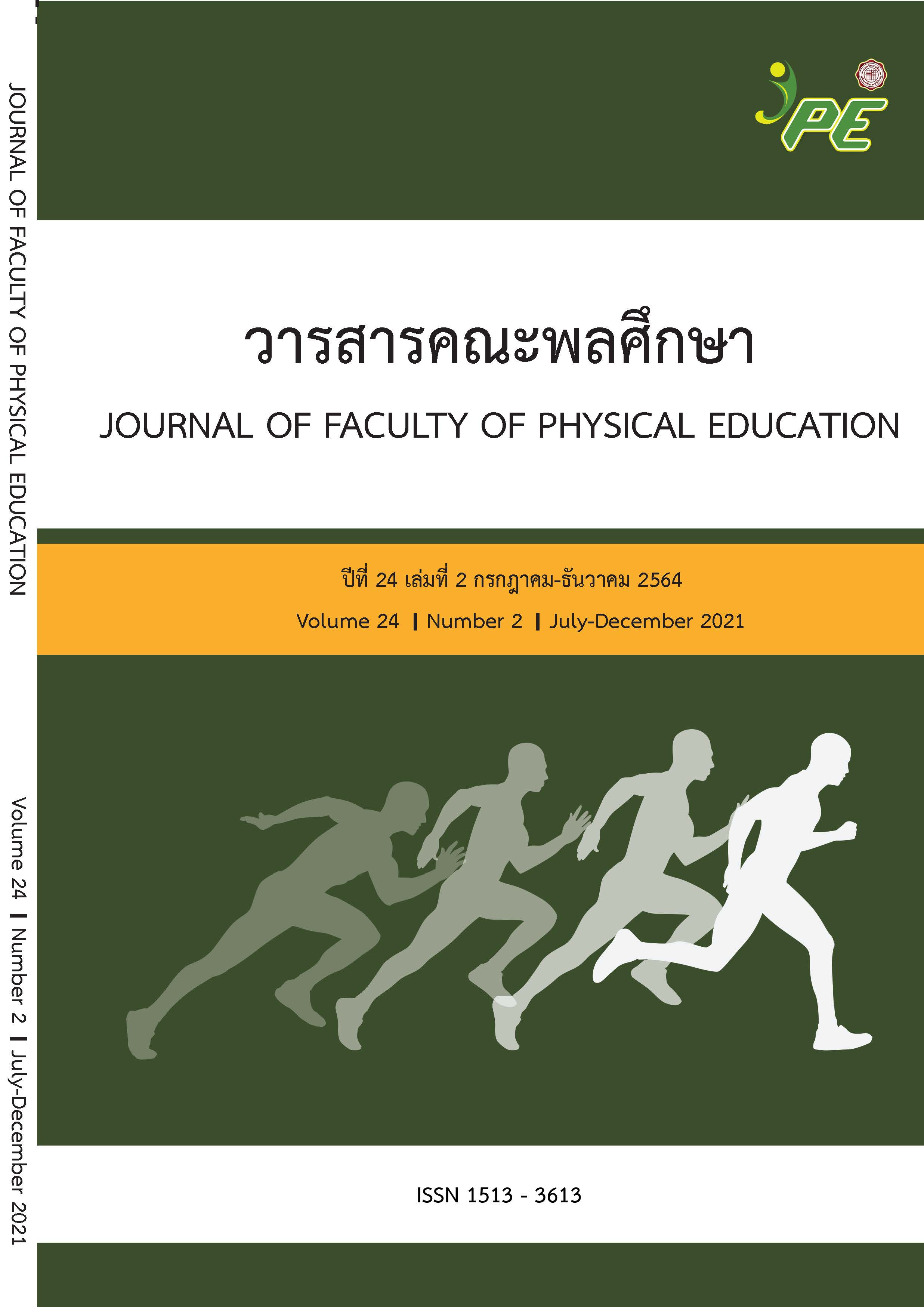EFFECTS OF NEUROMUSCULAR COORDINATION TRAINING AND SKILL TRAINING ON ABILITY OF INSIDE KICK SKILL IN TAKRAW AMONG GRADE SIX STUDENTS
Main Article Content
Abstract
Purpose: The purposes of this quasi-experimental research were to study and compare the effects of
neuromuscular coordination training and skill training on ability of inside kick skill in Takraw among grade
six students.
Methods: The samples were 40 Grade Six students. They were selected by purposive sampling into
two experimental groups of 20 students. The first group had neuromuscular coordination training as well as
with skills training. The second group trained with Takraw skill training. The research instruments included
the following: (1) the Takraw skill training program; (2) neuromuscular coordination training program;
(3) the inside kick skill in the Takraw test. The duration of this program for eight weeks. The inside kick skill
of Takraw test was performed by all of the participants before training, after weeks 4, 6, and 8. The data
were analyzed using mean and standard deviation, the One-Way Analysis of Variance with repeated
measures, and Two-Way Analysis of Variance with repeated measures.
Results: After 8 weeks of training, the mean of the inside kick skill of Takraw among two groups increased
before training at a statistically significant level of. 05. When comparing the interactions of all groups,
the skills of the groups trained with neuromuscular coordination training together with skill training was
better than the skills of the group trained with Takraw skill training at statistically significant level of .05.
Conclusion: Neuromuscular coordination training program to improve ability of performance. The effects
of neuromuscular coordination training program together with Takraw skill training program towards inside
kick skill of Takraw as well.
Article Details

This work is licensed under a Creative Commons Attribution-NonCommercial-NoDerivatives 4.0 International License.
Any articles and comments This journal is the opinion of the author. The Faculty of Physical Education doesn't always have to agree. Anyone wishing to publish or distribute a message must obtain direct permission from the author.
References
.Watchayakarn K. Skills and Instructional Sepaktakraw Sport. Bangkok: Chulalongkorn University Press;
Ngammoo J. Physical fitness needs of Sepaktakraw players. Bangkok: Chulalongkorn University; 2014
. Sriramatr S. Sports Training Principles For Sports Trainers. 5 th ed. Bangkok: Chulalongkorn University
Press; 2017.
Kanjanasorn W. Effects of Cooperative Learning (CL) on Takraw Playing Skill by Inner Side of Foot and
Satisfaction of Physical Education Students, Faculty of Education, Khon Kaen University. Journal of
Education Khon Kaen University. 2016; 39(4): 53-64.
.Krabuanrat C. Table 9 Channels and Brain Development. 2 nd ed. Bangkok: Health and psychomotor
skills development center Kasetsart University; 2009.
. Wonnabussapawich P. Sports Training Techniques. Nakhon Ratchasima: Faculty of Science and
Technology Nakhon Ratchasima Rajabhat University; 2017.
Krabuanrat C. Science of Coaching. 2nd ed. Bangkok: Sintana Copy Center; 2018.
Amornvanitsak A. Effects of combined training on shooting performance in futsal players
Watsothornwararam Worawihan School. Bangkok: Srinakharinwirot University; 2020.
Moollasat J. Effective of nine square upon to agility of pratomsuksa boy student. Bangkok: Chandrakasem
Rajabhat University; 2009.
Noosuwan T. Effect of Nine square Training Program on agility of Male Sepaktakraw Athletes. Songkhla:
Thaksin University; 2013.
Sinboonma B. Result of blended training that affected to speed and agility of volleyball players in primary
school level at Banphotphisai district. Nakhon Sawan: Nakhon Sawan Rajabhat University; 2015.
. Canlı U. Effects of neuromuscular training on motoric and selected basketball skills in pre-pubescent
basketball players. Universal Journal of Educational Research. 2019; 7(1): 16-23.


